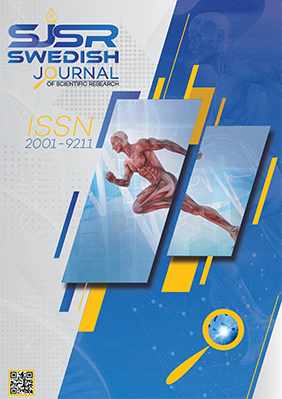SWEDISH JOURNAL OF SCIENTIFIC RESEARCH
SJSR January issue2017 | Issue 1 / JAN |
|---|---|
|
P. 1 - 6
SJSR-00071
|
We attempt to highlight of the effect of intensive training on global self-esteem (GSE) and relationship between specific self-esteem and anaerobic performances among the young elite soccer player. Thirty-two healthy, elite soccer men from the same 1st division club participated in this study (mean (SD) age 21.4 (0.9) years). None of the participants were participating in any other physical activity except the soccer training and the high-intensity sprint training (HIST). HIST consisted on repeated-sprint exercises performed during the warm-up period for eight-weeks (3-times a week). Before (T1) and after (T2) the HIST, all participants performed the repeated-sprint ability test (RSA) which consisted in 7x30-m runs with 30-s of active recovery. During the recovery, a French translated form of the RES 10 scale was used to determine the Global Self-Esteem (GSE) change for all participants before and after training. We observed significant (p<0.05) increase of GSE results after training for all participants. In fact, results were increased from 29.81±2.92 in T1 to 32.4±3.00 in T2. Before training and after training, the total sprint time (TT) was positively correlated to GSE (r= 0.64, p<0.01 in T1 and r= 0.66, p<0.01 in T2). In addition, the fastest time (FT) was also positively correlated to GSE before (r= 0.53, p<0.01) and after training (r= 0.45, p<0.01). Maximum speed sprint workouts are an effective way to improve anaerobic performances in elite soccer. The Short intense sprint exercise training should be integrated into the training program for development of self-esteem in young soccer. Selmi W, et al, 2017. Changes in Global Self-esteem after Short-term Sprint Interval Training in Elite Soccer Players. Swedish Journal of Scientific Research.; 4(1):1-6.
|
|
P. 7 - 12
SJSR-00072
|
This study aimed to prepare plyometric physical training in order to develop speed strength of arms, legs and accuracy of pressed serve by volleyball players. The researcher proposed that there are significant differences among arithmetic means between pre- and post- test results for the controlling and empirical group in favor of empirical one. Sample of the study consists of (16) students of Al Mustanseriyah University’s volleyball team divided into two empirical and control groups each of which consists of (8) players. The researcher concluded efficiency of physical training using plyometric method to develop speed strength and accuracy of pressed serving performance by players. Mahmood Qasim Ali, 2017. The Effect of Plyometric Training in Developing Speed Strength and Accuracy of Performing Pressed Serving Skill by Volleyball Players of Al Mustanseriyh University. Swedish Journal of Scientific Research.; 4(1):7-12.
|
|
P. 13 - 17
SJSR-00073
|
This study aimed to use plyometric training with training means consistent with the sample in order to develop explosive strength of upper extremities on performing long pass over shoulder to goalkeepers during fast breaks in handball. The researcher used the empirical method for the single group to solve the group. The sample was represented in handball players of Middle Euphrates in Al Sania Club (3 goalkeepers). Next, the researcher selected accuracy of performing long pass over shoulder for goalkeepers to achieve objectives of the study. An exploratory trial was made and post-tests were applied in the study, then the researcher applied plyometric training for a period of 6 weeks and by (3) training units per week. After obtaining results, the researcher processed through the use of non-parametric statistics. After analyzing results, the researcher reached findings the most important of which is that plyometric training has a positive influence on the development of explosive strength of upper extrimities and thus the development of long pass performance over the shoulder by handball goalkeepers. Atheer Abdullah Hussein, 2017. The Effect of Plyometric Training in Developing Explosive Strength on Performing Long Pass Over Shoulder to Goalkeeper during Fast Breaks in Handball. Swedish Journal of Scientific Research.; 4(1):13-17.
|
|
P. 18 - 24
SJSR-00074
|
The aim of this study is to describe and analyze the disruptive behaviors portrayed by secondary level students. The study is based on their level of disturbance during a Physical Education (PE) course and is conducted by a trainee teacher. A delayed video-scopic analysis has been performed using the Siber management module (2001). It helped unveil a total of 929 disruptive behaviors (DB), 681 of which were noticed by the trainee teachers and the remaining 248 weren’t. The results show that the Physical Education courses observed display a very high level of disturbance. With an average of 31 DB per course (∼0.56 DB per minute), there is an incident every two minutes. The results show a dominance of intrusive DB (70.7%) which are able of highly disturbing the teaching process, opposed to 29.3% of minor intrusions. These results presume that the learning conditions during the observed courses weren’t optimal. Therefore, we should work hardly in the reasons and correspondents solutions. Talel Maddeh, et al, 2017. Analysis of Disruptive Behavior Portrayed by Secondary Level Students During Physical Education Courses Conducted by Tunisian Trainee Teachers. Swedish Journal of Scientific Research.; 4(1):18-24.
|


